CHAPTER 7
OTHER MAKES OF MTS AND
EARLY IMTS EQUIPMENT
As mentioned above, even though IMTS equipment was available since 1965, most telephone companies throughout the 1970's remained as manual-MTS systems. As a result, smaller firms continued to manufacture MTS car telephones, probably primarily for the California market, usually using used-refurbished RF drawers by GE, Motorola and others but adding control heads and digital decoders of their own design and manufacture. Some of these are shown below.
CANYON
Canyon Communications, of Newhall, California, was most famous for its manufacture of attaché phones but also made the RF sections of its attaché phones available as conventional mobile units ( MTS) in the late 1960's and early 1970's. There were several models, one of which curiously had the RF channel oscillators built inside the control head as shown below. The construction quality and appearance of these Canyon units appears a bit crude. It's easy to recognize that the head below started life as a Western Electric Trimline® wall phone.
Canyon also manufactured a radio package which apparently never came with a control head of their own manufacture. Labeled Mark 900, the same as their attaché phones (see below,) this was rather confusing. Customers were evidently expected to use a Secode or (later) Glenayre or Harris head with it. There was no logic inside the unit itself and it is not the same as the Mark 900 attaché phone. Canyon also manufactured Mark 700 and 800 phones, apparently attaché units, but no data is available.
Click here for interior view of the above MK900 chassis
Canyon was acquired by GCS in the late 1970's, which did a lot of re-engineering and cleaning up of the basic designs, and offered the final, improved versions of the Mark 900 shown above and the fully IMTS attaché phone described in later pages.
Click here for examples of GCS sales literature
CSI
Communications Signaling Inc. was a Los Angeles used-equipment refurbisher which sold mainly Motorola and GE radio packages, some with new control heads of their own construction for MTS use, in the years before IMTS became standard in California (or most other states.) In the 1980's, they also sold both MTS and IMTS reconditioned radios with Glenayre IMTS control heads, as IMTS mobile telephones. They seem to have gone out of business in the early 1990's. The head below is labeled CSI 209 and was supplied connected to a GE CC56 radio package in which the original IMTS supervisory logic had been removed. It was sold under the model name "Superior" and could be had in sixteen different colors! There were two buttons on the handset - - one is the push-to-talk while the other is the channel advance function. The pushbutton caps may not have been black as originally shipped. The decoder circuitry is built into the control head along with a small buzzer. Another example is shown with the International Systcoms mobile telephone shown below. When this control head is in the "scan" mode, the light pattern on the channel lamps is fascinating to watch. These were also sold with a refurbished Systcoms mobile radio drawer (see below.)
INTERNATIONAL SYSTCOMS
Systcoms was a Canadian company later absorbed by Novatel in the 1980's. See the Systcoms information farther down in the 1974-83 category.
The Systcoms Century radio package in the photo below originally came with a 13 channel Canadian MTS control head in the early 1970's or late 1960's. Here, it has been modified in approximately the mid or late 1970's to use a CSI scanning MTS head, built into an Automatic Electric Starlite telephone housing. The various channel lamps illuminate as the unit is scanning and stop on channels which are available, per settings by the user. The control and signaling logic is entirely contained within the control head, via a set of somewhat simply made circuit boards and pin-jack fields. The transceiver is duplex. This would have been usable in the California Pacific Telephone system up until the 1982 switch to IMTS, or in other areas which were still manual, MTS format (a surprising number of companies only converted to IMTS near the very end of this technology.)
Systcoms VTR-74
The Systcoms VTR-74 was a smaller package radio telephone intended for the Canadian market but which saw use in the United States an=s an MTS format car telephone primarily due to the difficulty independent two-way radio shops had in obtaining any car telephones for sales to customers in the 1960's and beyond. the VTR-74 appears to date from the early 1970's and the example shown below can be seen to have the extra two Canadian car telephone VHF channels. At least in California, where this example was used, it would have become useless in 1982 when Pacific Telephone switched to IMTS - only. This format of equipment would have been best used in trucks and commercial vehicles, t would have been ugly and hard to mount in a passenger car. There may have been an extension cable to mount the control head separately.
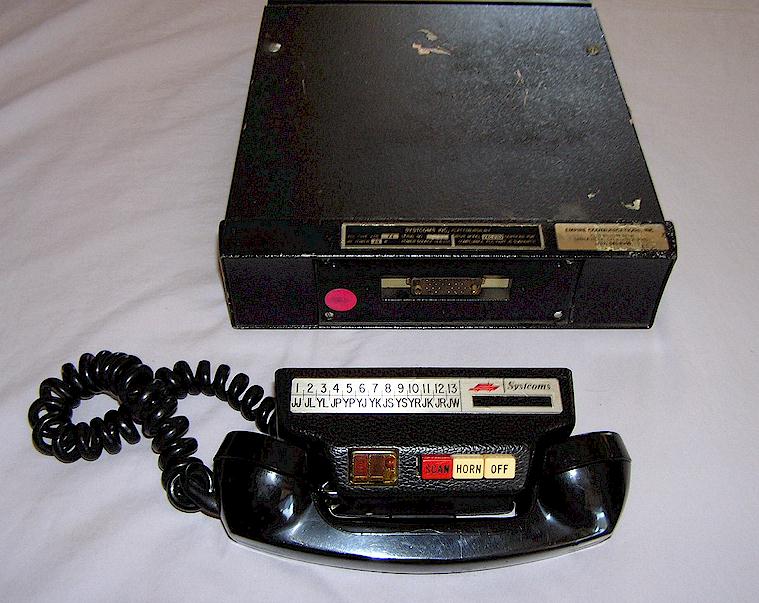
LIVERMORE DATA
Livermore Data Systems of Livermore, California acquired the rights to a mobile and/or attaché phone made by S/C/M Melabs (see below) in 1970 and began production in that year with the LAP-1000A Attaché phone. They had already been engaged in production of computer modems and related items since the 1960's. Their first product was the Envoy 150, an MTS telephone sold primarily as an RCC item. The Envoy 150 was rapidly discontinued and the same item became the "Satellite Channel Search Car Telephone," Model LCP-1010A. The RF package of this telephone looked identical to the later "Satellite" phones as shown below. The control head was a Secode VP-1 style head, which in appearance is the same as the "MJ" ITT control head shown above except that there is a blank plate where the dial would be. See the Livermore Data category in Chapter 8 for more information about this company with product photos.
SYMETRICS
Symetrics of Satellite Beach, Florida was a small manufacturer which was making both MTS and IMTS mobile telephones by 1970, but little information is available. In 1976 the mobile telephone division of Symetrics was spun off and purchased by Regency Electronics, and eventually became Regency Land Mobile, manufacturing business band radios. However, Regency Land Mobile continued to produce large quantities of Symetrics mobile telephones. A large number were sold to the middle east, particularly Iraq. Both the Symetrics and Regency Land Mobile radios were produced at 1227 S. Patrick Drive in Satellite Beach. In 1987, that location was closed and the company moved to West Melbourne, Florida and renamed RELM. (Thanks to Ron Ellis, KR4ZB for this info!)
The photo below has been blown-up from their ad in a 1970 issue of Communications magazine. Note that the head must have been mounted as a prop in the photo, a Camaro interior, because the gearshift looks like it would have had a hard time reaching PARK with that head in that position! Symetrics manufactured two mobile phone versions, the MTS-11 and the IMTS-11, at least through 1976. As the model numbers imply, the MTS-11 was an MTS manual phone while the IMTS-11 was the IMTS version. Power outputs were 20 Watts and there was no UHF version. Symetrics is still in business as a defense contractor.
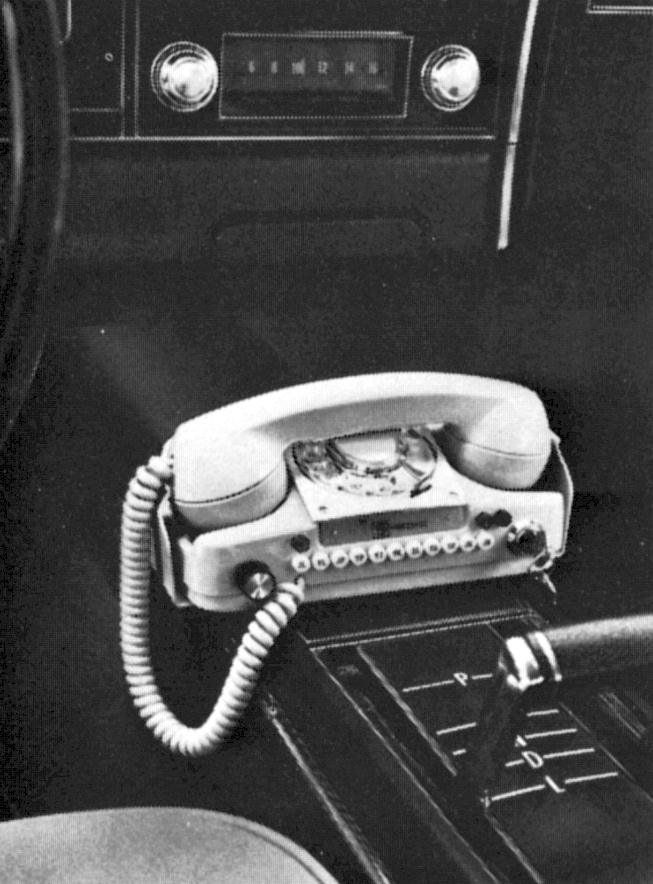
CLICK HERE TO VIEW THE FULL AD FOR THE PHONE ABOVE
Here are some interesting photos received in March 2014 showing a Symetrics phone found still installed in a 1971 Pontiac. Note that the control head has a slightly different layout with the key on the opposite side from above. The phone below may be the MTS 11. Unfortunately many of the numbered lenses have been broken.
S/C/M - MELABS
Melabs, a division of Smith Corona, the typewriter manufacturer, acquired an attaché phone design in 1967 from Carryphone Co. that appears to have been the first portable MTS car telephone. Carryphone had contracted with Melabs to build the phone and then was unable to pay for the production of phones and evaporated. Melabs then attempted to sell them themselves with the Melabs labeling. Melabs' product was taken over later by Livermore Data (see Livermore Data information below.)
Melabs seems to have also produced a mobile version as well, which was the predecessor of the Livermore Data models, but information is lacking on this point.
See more discussion of S/C/M Melabs in the next chapter ( "Attaché Phones, Chapter 8.)
TAMAPHONE
This really doesn't fit very well in the any of the page categories I chose for this topic, but here is the rather strange Tamaphone Executive MT-155, from the mid or late 1970's, courtesy of Laird Kelly, K7FZL. These were made in Japan by Tama Denki, Ltd., the manufacture of the Wilson branded amateur and commercial FM hand-held radios sold in the USA during that period. It appears to be simply a Wilson T-1505 1W/5W handheld with crystals for MTS (or RCC?) channels. Laird found an ad for a used one in 1984 which stated that the original price was $ 2400. There was also a model MT-152, the difference is unknown. It was MTS only.
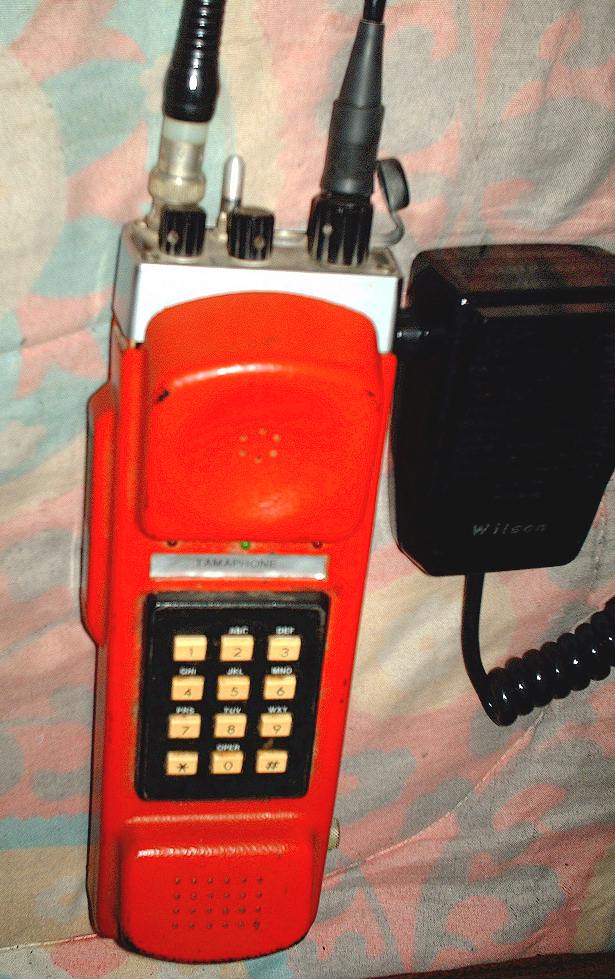
INDUSTRIAL RADIO - ARISTOCRAT
Industrial Radio of Chicago was primarily known for its manufacture of portable two way "pack set" and "field phone" police radios. In approximately 1965 they marketed the "Aristocrat," a duplex MTS telephone using an Automatic Electric dial "Starlite" telephone as the control head, which was actually just the older ITT "Cinderella" phone mentioned above. Evidently ITT sold the rights to the phone when it exited the car telephone business, and there is evidence that Industrial was the actual manufacturer of the ITT Kellogg branded phones in the first place. In 1965, IMTS had already been introduced, technically making the Aristocrat obsolete, although most areas of the country remained MTS throughout the 1960's if not well into the 1970's. California, in fact, did not convert to IMTS until 1982 ! Industrial Radio had disappeared by approximately 1968.
The Aristocrat shown below in the advertisement is the 11 channel model. There was also a 5 channel model shown below that and on the separate Aristocrat page linked below.
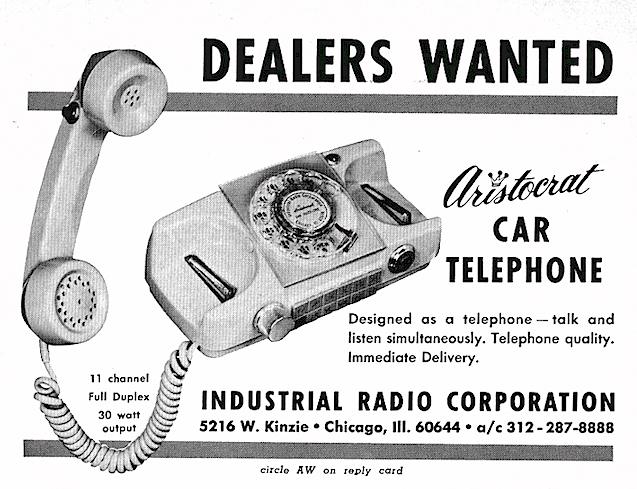
11 Channel Head:
5 Channel Head:
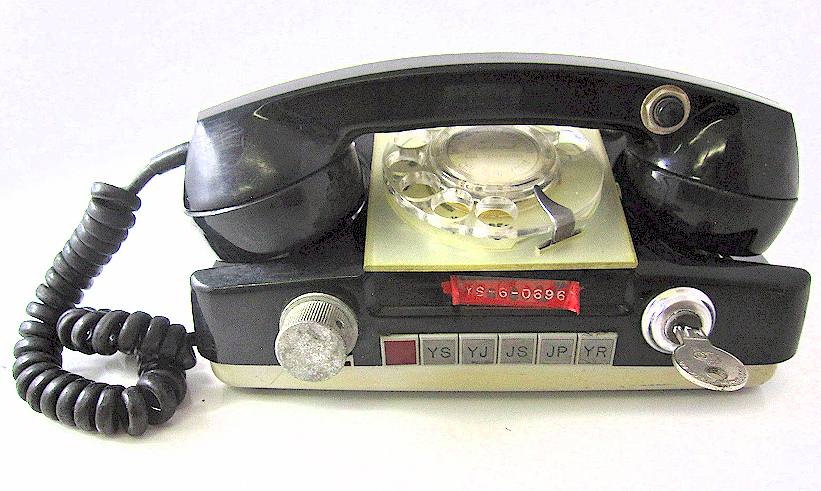
11 Channel RF Section:
5 Channel RF Section:
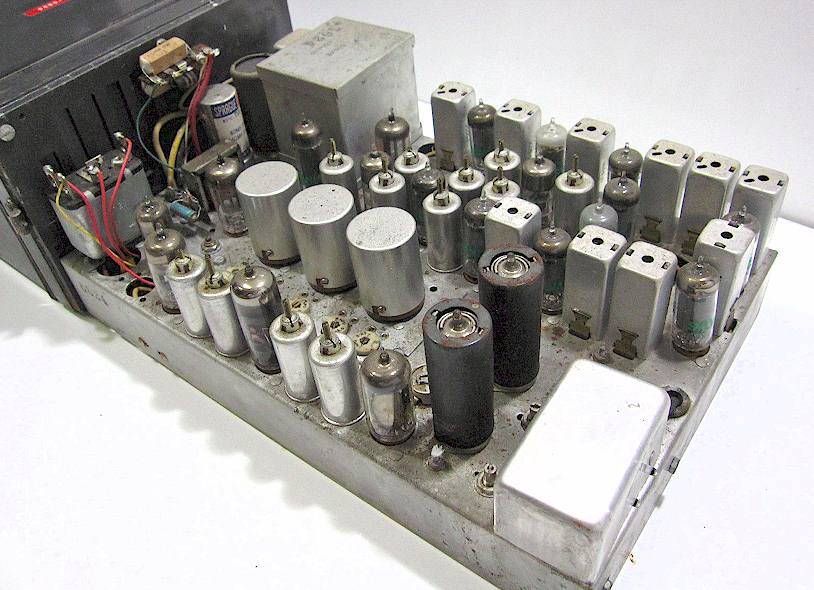
CLICK HERE FOR MORE PHOTOS OF THE ARISTOCRAT MODELS
GLENAYRE 1400 SERIES MTS HEAD
Glenayre is a Canadian company that has manufactured paging transmitters and mobile telephones for both the Canadian and American markets. The 1400 appears to have been one of their first mobile telephone accessory control heads, intended to interface with the radio package of various other manufacturers. This is MTS with outscan. In other words, the head scans for an unused channel and locks on it. The handset is then removed and the push-to-talk switch activated to place the phone on the air and alert the operator, who would dial the call. The 1400 head probably dates from the mid-1970's, more or less. It is not known whether any were sold within the United States. An example of a 1400 C head is shown below. Note the logo is "Bell Canada," not "Bell System." This head was the foundation for the IMTS version GL-2000 heads, shown in Chapter 10. Note the "old" 5-digit mobile number. This example is from Toronto.
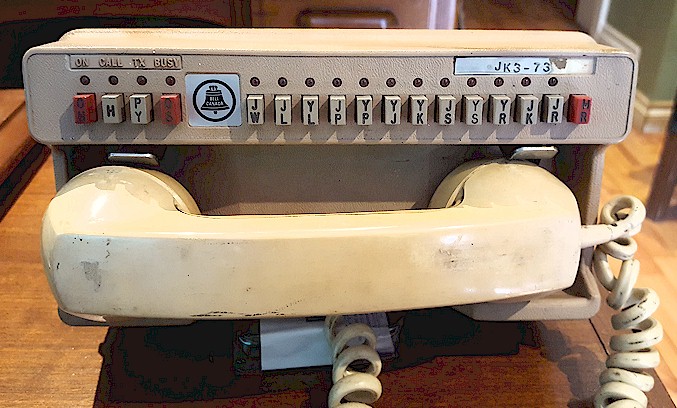
Photo courtesy Don Jones
Ver. 09/03/2025 ©Geoffrey C. Fors 2004 All rights reserved